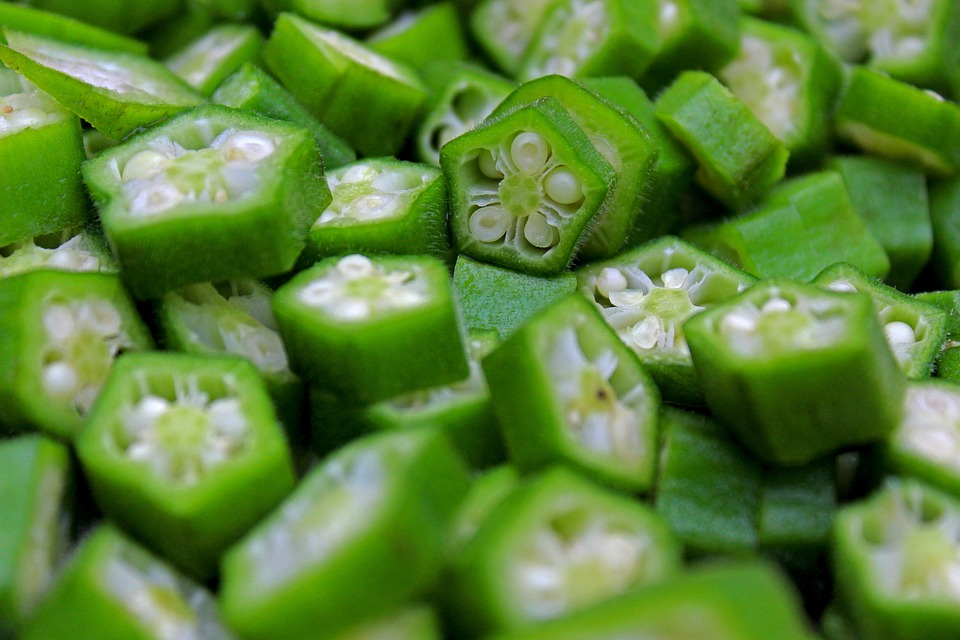Okra is mostly eaten in the South of America. However it is not widely known in other parts of the world.
Including okra in your diet may benefit people with diabetes, so consider setting aside some space for this particular vegetable!
What Is Okra?
Okra, which is actually a fruit, originated in Africa and is usually cooked in the same way that vegetables are, for example, boiling, roasting, or frying. It thrives in warm temperature zones, such as the American South, which provides it with the right amount of heat and moisture to be able to be considered a part of several recipes unique to the area. You can eat the entirety of an okra, from the stalk to its seeds. If you have a okra plant, you can use the leaves, blooms, and flower buds of the plant as greens, as suggested by North Carolina State University Extension.
Okra Nutrition
Okra contains a vast amount of essential vitamins, minerals, and nutrients, like vitamin C, riboflavin, folic acid, calcium, and potassium, as reported in Molecules journal. Regarding the viscous, gooey liquid that is produced when slicing and cooking okra? Grace Clark-Hibbs, M.D.A., R.D.N., a registered dietitian and founder of Nutrition with Grace, has stated that the slimy substance, technically known as mucilage, contains a great deal of fiber. Okra’s dietary fiber is beneficial for help with digestion, blood sugar regulation, and heart health.
Here’s the nutritional profile of 1 cup (~100 grams) of cooked okra, according to the United States Department of Agriculture:
- 33 calories
- 2 grams protein
- < 1 gram fat
- 7 grams carbohydrate
- 3 grams fiber
- 1 gram sugar
Seven Benefits of Okra for Diabetes
1) Rich in fiber.
Okra, similar to other plant-based foods, contains an abundance of dietary fiber. Fiber is a type of carbohydrate but the digestive system is not able to take it in. Foods that are high in fiber don’t cause a big spike in blood sugar, plus they are lower in calories because fiber doesn’t contribute to the caloric count.
Okra can help those with diabetes by providing a feeling of fullness, and consequently may be useful in promoting weight loss. A reduction of approximately 5-7% of your original weight can produce a big difference in blood sugar and may even be effective in preventing diabetes in those with prediabetes.
Soluble fiber can be beneficial in maintaining healthy cholesterol levels. Those suffering from diabetes are apt to have an abundance of bad cholesterol and insufficient amounts of good cholesterol, raising the possibility of developing heart disease.
In an experiment involving animals, mice who ate okra powder along with a diet that was known to lead to high cholesterol levels had lower cholesterol than rats who just ate the same hyperlipidemic diet.
The cholesterol levels in the mice increased proportional to the amount of okra powder consumed; the mice that ingested the most okra powder experienced the most notable rise in cholesterol and triglycerides.
Okra contains roughly 3 grams of fiber per cup (which is equivalent to around 12% of an adult’s daily recommended intake).
2) It may help lower blood sugar.
Okra is beneficial for people with diabetes, as it has the capability to decrease blood sugar levels.
In animal experiments, rats that were given okra powder experienced sizeable drops in their fasting blood glucose levels, enhanced insulin obstacles, and lesser harm to their pancreas.
One of the most important components in the human diet are carbohydrates (carbs). They draw considerable interest in diabetes because they change into glucose or sugar after they have been consumed.
Out of the main nutrients–carbohydrates, protein, and fat–it is carbohydrates that have the greatest effect on blood sugar levels.
Okra is not high in carbohydrates, with just 4 net carbs per cub. Net carbs are the amount of carbohydrates that can influence the level of glucose in the blood and are determined by eliminating the grams of fiber from the whole carbohydrates.
Therefore, higher fiber foods have lower net carbohydrate counts.
3) May help fight stress.
Controlling diabetes can be a source of worry and can have a negative effect on the health of people who experience large amounts of tension and other mental health conditions. The secretion of hormones associated with stress can result in a higher blood sugar level for those with diabetes due to increased insulin resistance.
Okra boasts polyphenols, an antioxidant that could provide anti-stress benefits.
Studies performed on animals indicate that okra has adaptogenic properties that can reduce stress. Scientists recommend that okra be consumed due to its potential benefits in the treatment of illnesses related to stress as well as dementia.
Although these findings cannot be directly correlated to human patients, the research does appear to be beneficial for those with diabetes.
4) Low in calories.
Individuals diagnosed with diabetes, especially type 2, are usually carrying excess weight. It is believed that nearly 85% of folks suffering from diabetes are either overweight or obese. Carrying extra weight can exacerbate insulin resistance, leading to an increase in blood glucose.
Okra, similar to other veggies, has very few calories, which can be used to help lose weight if combined with other sensible eating choices and active lifestyle habits. Studies have proven that eating lots of vegetables can help prevent weight gain. Therefore, okra may be beneficial for those with diabetes as it can help one to lose weight around their waist.
5) Rich in antioxidants.
Okra offers another advantage to those suffering with diabetes; it contains a high concentration of Vitamin C, a potent antioxidant. Antioxidants help prevent cell damage by free radicals.
This can hasten the aging process and make one more prone to developing cancer. Antioxidants are beneficial in reducing inflammation, which is commonly linked to diabetes.
6) Rich in nutrients.
Okra provides a range of essential vitamins and minerals, including calcium, vitamin A, vitamin B6, and magnesium. Vitamin A can be especially helpful for maintaining good vision, something that high blood sugar levels can interfere with.
Okra contains folate, a vitamin essential for preventing birth disorders in early stages of gestation.
Women with diabetes who are attempting to become pregnant should consume a sufficient amount of folate when aiming to conceive and continuing through the pregnancy.
It is of such significance to avert congenital impairments that folic acid is incorporated into flour and other commonly eaten ingredients.
7) High in protein.
Okra is one of the few vegetables that provide quite a bit of protein. A single cup of the vegetable offers nearly 2 grams of protein, which is quite a lot for a vegetable.
Adding proteins to your diet can keep you feeling full and help manage your blood sugar levels since these kinds of foods don’t affect blood sugar.
Potential Risks of Okra
Prone to kidney stones? Cautiously consume okra as it contains oxalates, according to Clark-Hibbs, which elevate the likelihood of encountering kidney stones again if there is a previous record of them. Because of too much oxalates, a combination with calcium will be made which results in calcium oxalates, a major part of kidney stones, according to her reasoning. A 2018 study indicates that consuming an abundance of oxalates at one time boosts the amount of oxalates released through urine, increasing the risk of developing kidney stones that travel through the kidneys. Those who are more liable to form kidney stones should keep their ingestion of food items with oxalate in check.
Mathis suggests exercising caution if you’re taking anticoagulants, which are medications meant to stop the formation of blood clots. Okra contains lots of vitamin K, a vital nutrient which helps in blood clotting and is something blood thinners work to prevent. Did you know that blood thinners are used to avoid blood clots developing in people with conditions like atherosclerosis, which may otherwise result in a heart attack or stroke? However, it is not a good idea to eat food items rich in vitamin K (like okra) in large amounts as this can negate the effects of the blood thinner.
In brief — If you are at risk for developing stones or you are on a blood thinner, confirm with your physician how much okra you can safely consume before eating it.
Forms of Okra
Whole form
Okra can be bought both fresh and frozen in its entirety. If you have diabetes and want to include okra in your meals, this is the most practical and accessible option.
It could be more difficult to take off the slimy substance from frozen okra in comparison to fresh, thus the choice of form is yours depending on what you like concerning the specific texture of okra.
Okra water
An alternate way to ingest okra is to drink okra water, which is created by allowing okra pods to sit in water for a period of 24 hours. Those who don’t care for the feel of okra but still wish to get its favorable health properties can go for okra water.
Okra powder
Okra powder, which is composed of dried okra leaves and okra skins, is a handy way to obtain the health benefits of okra. You can incorporate okra powder into dishes much the same way as you would with other herbs and spices.
Okra extract
Okra extract is a condensed version of okra pods, which are taken from the okra plant. Okra extract can be taken as a dietary supplement.
How to Cook Okra
Okra is accessible in various ways, including fresh, frozen, canned, pickled, and dehydrated powder. Some stores might also sell dried okra snacks. It can be retrieved in the frozen food section either by itself, breaded, or in a prepackaged meal. In other words, unprocessed, both fresh and frozen, non-breaded food selections offer the best nutrition benefits since they don’t contain preservatives such as sodium.
As for okra powder? Instead of replacing a vegetable, it’s more commonly used as a flavor enhancer. Using spices rather than salt or pickled ingredients is a more beneficial option, but you’re not likely to stumble across it during your next visit to Whole Foods. Instead, head to a specialty store or the internet.
When purchasing fresh okra, look for vegetables that are firm and have a vibrant green color, while avoiding any that are dull or soft, because this could signify it is decaying, based on the University of Nebraska-Lincoln. Put unwashed okra in an airtight container or plastic pouch and keep it in the fridge when stored at home. You should be aware that okra has a short shelf-life, so it is best to consume it immediately or within a period of 2-3 days, according to advice from the University of Arkansas.
Rather than eating okra raw, the majority of folks choose to cook it, as the outer skin has a slight prickliness that is not detectable after it is cooked. Fresh okra can be roasted, fried, grilled, or boiled. However, previously stated, when okra is sliced or cooked, it produces the gooey mucilage that is generally not popular.
Use larger chunks of okra in order to reduce the sliminess, since cutting it into smaller parts increases the sliminess that it is known for. Jones suggests using dry methods of cooking like frying, roasting, grilling in contrast to moist ones such as steaming or boiling, since adding moisture to okra can increase its slimy consistency. Cooking without added liquid includes high heat preparation, which reduces the cooking duration and thus limits the slime released from the okra. Finally, you can reduce the amount of slime by including an acidic component such as tomato paste, lemon juice, or garlic sauce. Goo, be gone!
Ready to give okra a spin? Here are a few tasty expert-approved ways to use okra at home:
As a roasted dish. It is effortless and extremely savory to prepare okra by roasting it. Cover a baking tray with aluminum foil or parchment paper, place the okra in one layer, spray it with some olive oil, and season with salt and pepper depending on your preference. This will make the okra more tender while preserving its crunchiness and avoiding the sticky consistency that can happen when boiled.
As a sautéed dish. Cook okra with your preferred seasonings by sautéing it. Start by heating some oil in a big skillet on a medium-high flame. Simmer okra for four to five minutes, or until it turns a vivid green color. Season with salt, pepper, and other seasonings before serving.
In stir-fry. Elevate your next weeknight stir-fry with okra. This meal requires a speedy preparation process, which will minimize the amount of slime.
In stews and soups. If you use the correct strategy, okra’s slimy coating can work to your advantage. Cornstarch can be used to make dishes like stew, gumbo, or soup more thick. Include diced okra in your soup about 10 minutes before it is finished cooking.
In a salad. Maximize the benefits of seasonal fruits and vegetables by combining okra with other summer vegetables. Cooked okra can be chopped and incorporated into a tasty and seasonable salad of tomatoes and corn.
Conclusion
Okra is a flowering plant consumed as a vegetable. There are numerous benefits of okra for diabetes. The prospect of it enhancing cholesterol levels, reducing blood sugar, and augmenting strain resistance is present.
Okra contains a significant amount of folate, vitamin C, magnesium, and dietary fiber, all of which are essential vitamins and minerals. And it is also a source of polyphenols (antioxidants). Okra has minimal amounts of carbohydrates, so it does not considerably increase blood sugar levels.
You can eat okra entire when you are preparing a meal. Okra can be consumed in multiple formats, such as in the form of a powder, extract, or water. Okra has almost no issues with safety, and thus is an excellent option for diabetics who intend to lower their blood sugar level and enhance their general health.







